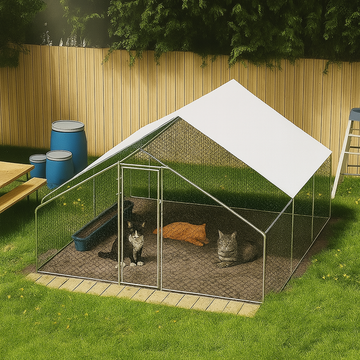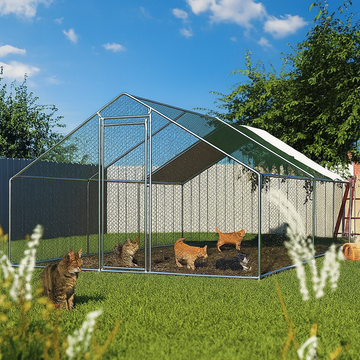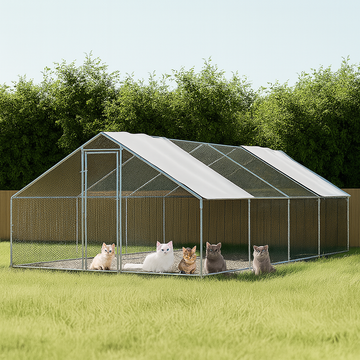Introduction
Cats are curious creatures by nature, and while many enjoy lounging indoors, there's something magical about letting them safely explore the outdoors. But the open world comes with risks—traffic, predators, toxic plants, and more. That's where cat cages for outside and catios for cats come in. These structures provide a safe, enriching outdoor experience while protecting both your pet and the local wildlife.
In Australia, cat confinement laws and a growing awareness of native wildlife protection have driven the popularity of outdoor cat cages. Whether you're living in an apartment or a spacious home, there's a perfect catio design for every lifestyle and feline personality. But how do you choose the right one? From sizing and materials to location and safety features, this guide breaks down everything you need to know to select the best large cat enclosure or compact outdoor haven for your furry friend.
Benefits of Outdoor Cat Cages and Catios
Enhanced Safety and Protection
Letting your cat roam freely outdoors might sound liberating, but it often comes with serious risks. Cars, dogs, snakes, and even other cats can pose dangers. Cat cages for outside act like a protective shield, keeping your cat away from harm while still giving them the chance to enjoy sunshine, fresh air, and the chirping of birds.
These enclosures also prevent unwanted escapes. Cats are natural wanderers and escape artists. A well-built, secure catio ensures they stay within safe boundaries without being confined to four indoor walls. If you have a curious climber or a master of sneaky exits, a reliable enclosure is a must.
Additionally, many councils in Australia have implemented rules regarding outdoor pet safety, including requirements for cats to be confined to private property. A catio for cats helps you stay compliant with these laws while enhancing your pet’s quality of life.
Mental and Physical Stimulation
Cats are hunters, climbers, and explorers at heart. Confining them indoors 24/7 without stimulation can lead to boredom, obesity, and behavior issues like aggression or scratching furniture. Outdoor cat enclosures offer new environments to explore, sights to see, and scents to sniff.
From chasing leaves to birdwatching, your cat will benefit from the mental and physical exercise they crave. Elevated platforms, tunnels, and ramps within a large cat enclosure mimic natural habitats and encourage healthy activity. This daily stimulation reduces stress and helps prevent feline depression, especially in indoor-only cats.
Environmental Responsibility
Australia’s ecosystem is unique—and fragile. Free-roaming cats pose a significant threat to native wildlife, contributing to the decline of small birds, reptiles, and mammals. By choosing an outdoor cat cage, you protect your cat and the environment. It’s a win-win that allows your pet to enjoy the outdoors responsibly.
More Australians are becoming eco-conscious pet parents, and the rise of catios for cats reflects a shift toward sustainable, wildlife-friendly choices. It’s not just about protecting your pet—it’s about preserving the natural beauty of the land they live on.
Understanding Different Types of Outdoor Cat Cages
Portable Cat Cages for Outside
Portable cages are perfect for temporary use or for renters who need flexibility. These are lightweight, foldable structures that can be set up in a backyard, patio, or even taken to the park. While not ideal for long-term housing, they’re great for supervised outdoor time or travel.
They often include mesh panels for ventilation and a roof for shade. If your cat is new to outdoor time, a portable cat cage for outside can be a great way to introduce the concept without a big commitment.
Large Cat Enclosures for Multiple Cats
If you’re a multi-cat household or have the space for a more permanent solution, large cat enclosures are your best bet. These structures offer ample space to roam, climb, and relax. They can be standalone or attached to your home, providing a seamless transition between indoors and outdoors.
Many large enclosures feature shelves, bridges, tunnels, and multiple entry points. They can be fully customized or purchased as pre-designed kits. Ideal for energetic or territorial cats, these enclosures help reduce stress by giving each cat their own space within the structure.
Custom-Built vs. Pre-Made Catios
Custom-built catios are designed to fit your specific space and needs. You can work with a professional or take on a DIY project to create the ideal layout. Custom catios are often more expensive but offer the most flexibility in size, materials, and features.
Pre-made catios, on the other hand, come in standard sizes and are typically easier to install. Brands like Pets Gear, Catnets, and Omlet offer durable, attractive designs that suit various property types. Whether you're looking for a small balcony setup or a large cat enclosure, these ready-made solutions simplify the process without sacrificing safety.
Key Features to Look for in a Catio for Cats
Materials and Durability
The durability of your catio hinges on its materials. Choose rust-resistant metal or galvanized steel mesh to withstand Australian weather and potential intrusions. Wooden frames should be treated to resist rot and pests. High-quality materials may cost more upfront but last longer and require less maintenance.
Weather Resistance
Australia’s climate can be intense—scorching heat, unexpected downpours, and strong winds. Your cat cage for outside must handle it all. Look for UV-resistant roofing, waterproof flooring, and shaded areas. Consider weather-sealed hinges, screws, and latches for long-term stability.
Security and Escape-Proof Design
Cats are clever—and fast. Ensure the enclosure has no gaps, loose mesh, or weak joints. Double-lock systems, secure latches, and mesh with small openings prevent both escape and entry from predators.
Ventilation and Visibility
Cats love to observe. A good catio provides plenty of mesh openings for airflow and visibility. Make sure they have 360-degree views of their surroundings and proper air circulation, which helps them feel relaxed and entertained.
Choosing the Right Size: Small vs. Large Cat Enclosure
Factors Based on Cat Breed and Activity
Some breeds—like Bengals or Abyssinians—are more active and require larger spaces. If your cat is a laid-back Ragdoll, a modest setup might suffice. Consider how often your cat will use the enclosure and what type of activity level they display indoors.
Space Available at Home
Whether you live in a high-rise apartment or a spacious suburban home, there’s an enclosure to suit your layout. Balconies work great for vertical catios, while backyards offer more room for large freestanding cages. Measure your available area and plan for access points to ensure ease of use.
Number of Cats and Compatibility
If you have more than one cat, opt for a large cat enclosure with multiple levels and resting spots. This reduces territorial disputes and gives each cat its own domain. Enclosures with vertical height and divided zones help maintain harmony between feline roommates.
Location Considerations
Sunlight and Shade Access
Just like humans, cats enjoy sunbathing but need shade to avoid overheating—especially in the Australian heat. When choosing the location for your catio for cats, consider how much sun the area gets during the day. A mix of sunlight and shaded spots is ideal. Use roofing, shade cloths, or place the enclosure near a tree or covered patio to provide comfort throughout the seasons.
Sunlight is vital for vitamin D synthesis and overall mood enhancement, but too much direct exposure, especially on hot summer days, can lead to dehydration or heatstroke. If your catio is in a full-sun area, ensure there's adequate airflow and protection.
Ground or Elevated Setup
Depending on your home layout and cat’s habits, you may opt for a ground-based or elevated catio. Ground enclosures are great for larger spaces and often allow for more elaborate designs. Elevated catios or window box enclosures are ideal for apartments, allowing your indoor cat to get a taste of the outside world safely.
For shy cats, ground-level enclosures may feel more vulnerable. In such cases, choose an elevated setup with hiding areas or incorporate vertical features within the cage to give them a sense of security.
Integrating with Existing Structures
Attaching your outdoor cat cage to your house through a window, door, or pet tunnel creates a seamless indoor-outdoor experience. This allows your cat to access the catio whenever they like, reducing the need for supervision. It’s also a great way to encourage more frequent use of the enclosure.
Make sure the access point is secure, weather-sealed, and easy for both you and your cat to operate. Whether it's a slide-out window or a dedicated cat door, integrated designs offer more convenience and comfort for everyday use.
Matching the Enclosure to Your Cat’s Personality
For Timid or Indoor-Only Cats
If your cat has never been outside, they might be hesitant about new environments. For these cats, start small. Use a compact outdoor cat cage with cozy corners, enclosed tunnels, or even soft-sided carriers as part of the structure. Add familiar items like blankets and toys inside to ease their anxiety.
Shy cats do better in quiet, semi-private enclosures rather than open or highly visible ones. Limit external stimuli like street noise or busy walkways during their initial experiences.
For Curious, Energetic Cats
Active, playful cats need an engaging space. Choose a large cat enclosure with multiple platforms, scratching posts, ramps, and tunnels to climb and explore. These cats will thrive in setups with enrichment features like interactive toys, bird-watching perches, and sensory elements like cat-safe plants.
Design the enclosure to challenge their minds and bodies. The more freedom and fun you build in, the more satisfied and entertained they’ll be.
Senior or Special Needs Cats
Older cats or those with physical limitations need easy access and comfort. Avoid overly high perches or steep ramps. Opt for soft bedding, stable platforms, and shaded areas for relaxation. A ground-level catio for cats with simple pathways and fewer obstacles works best.
For these cats, safety is even more crucial. Make sure every surface is non-slip and that they can easily reach their favorite spots without jumping or climbing too much.
Budget Considerations
Cost Range of Cat Cages for Outside
Outdoor cat enclosures can range from affordable to premium depending on size, material, and features. Entry-level models, like small portable cages, start at around AUD $150. Medium-sized, pre-built catios average between AUD $400–$1000. Larger, custom-built structures can exceed AUD $3000, especially if they include complex designs and premium materials.
Budget for:
-
Materials (mesh, wood, fasteners)
-
Roofing and flooring
-
Installation or assembly (if not DIY)
-
Add-ons like toys, ramps, or beds
DIY vs. Professionally Installed Catios
DIY catios are budget-friendly and customizable. You control every detail and can tailor it to your cat’s habits. However, this requires time, tools, and construction skills.
Professionally installed or pre-made catios offer convenience and often better durability. Brands like Pets Gear, Catnets, and SecureaKat provide all-in-one kits or custom installations that meet Australian weather and safety standards.
Long-Term Investment Value
While the upfront cost might seem steep, a quality catio for cats is a long-term investment in your cat’s well-being. It can prevent costly vet bills from outdoor injuries, eliminate stress-related health issues, and extend your cat’s lifespan by keeping them active and safe. Not to mention, it can add property value and aesthetic appeal to your outdoor space.
Safety and Maintenance Tips
Routine Checks and Upkeep
To keep your cat cage for outside in top condition, schedule weekly checks for damage or wear. Look for rust on mesh, broken latches, loose screws, or signs of escape attempts. Addressing small issues quickly prevents big problems later.
Clean the enclosure weekly—sweep out debris, clean food/water bowls, and sanitize platforms and litter areas. This keeps it hygienic and inviting.
Weatherproofing and Pest Prevention
Install weather-resistant roofing and UV-blocking panels. In colder areas, add insulation or enclosed sleeping spots to keep your cat warm. Pest control is equally important—check for ants, spiders, and other bugs that may nest inside.
Elevate food dishes and ensure drainage systems are in place to prevent pooling or mold. A well-maintained catio not only looks good but ensures your cat remains healthy, happy, and safe all year long.
Legal and Local Guidelines in Australia
Council Regulations
As awareness of responsible pet ownership grows, more local councils across Australia are implementing rules to protect both cats and wildlife. Some councils now require cat confinement within your property at all times, meaning your cat cannot roam freely outdoors. A well-built catio for cats or cat cage for outside can help you meet these legal requirements while still giving your cat the outdoor freedom they crave.
Before building your enclosure, check your local council's pet regulations. Some areas may require permits or adherence to size and placement restrictions, especially for permanent or large structures. Complying with these guidelines ensures you avoid fines and demonstrates responsible pet ownership in your community.
Outdoor Pet Safety Laws
Beyond council-specific rules, national and state-level legislation supports animal welfare by encouraging confinement and secure housing for pets. Under these laws, pet owners must ensure their animals are kept safe, properly contained, and not a threat to the environment. Outdoor enclosures like large cat enclosures help meet these standards and are strongly recommended by animal welfare organizations throughout Australia.
Legal compliance is not only about avoiding penalties—it reflects a commitment to ethical pet care, reducing wildlife harm, and fostering safer neighborhoods for both animals and humans.
Where to Buy Quality Cat Cages and Catios in Australia
Trusted Brands and Online Stores
Australia boasts several reputable brands offering high-quality, safe, and stylish catios for cats and cat cages for outside. Some top names include:
-
Pets Gear – Known for its durable and affordable outdoor cat enclosures. Offers a range of sizes, from portable cages to expansive freestanding catios.
-
Catnets – Specializes in DIY-friendly netting kits and pre-made enclosures. Great for balconies, backyards, and fully enclosed setups.
-
Omlet Australia – Offers modular and portable enclosures with easy assembly and modern designs—ideal for renters and urban homes.
-
SecureaKat – Provides custom-built solutions with premium timber and aluminum materials tailored to fit your space and style.
-
Catnip Cat Enclosures – Known for heavy-duty, galvanised steel frame enclosures that offer top-tier security and longevity.
When shopping, compare factors like warranty, customer support, delivery options, material quality, and ease of installation. Look for brands with strong user reviews, especially from cat owners with similar needs.
What to Check Before Buying
Before purchasing any large cat enclosure or catio, evaluate:
-
Material durability – Weatherproof and rust-resistant?
-
Ease of assembly – Do you need professional help?
-
Security – Escape-proof design and pet-safe materials?
-
Compatibility with your space – Balcony, backyard, or wall-mounted?
-
Warranty and support – What happens if parts are missing or damaged?
Always measure your available space before ordering and ensure it matches the product dimensions. A little prep can save you major hassles post-delivery.
Real Cat Owner Stories and Experiences
From Apartment Dwellers
Tina from Melbourne lives in a high-rise and swore her indoor-only cat, Jasper, seemed restless. She installed a compact balcony catio from Pets Gear and noticed a transformation. “He lounges in the sun, watches the birds, and sleeps better than ever. It's like a spa retreat for him now.”
Multi-Cat Households
Liam and Emma from Brisbane have three cats—each with different personalities. They invested in a large cat enclosure with multiple levels, hiding spots, and climbing bridges. “At first we were nervous they’d fight over space, but now each cat has their favorite perch. The extra room made a huge difference.”
Outdoor-Enthusiast Cats
Sophie from Adelaide has a bold, curious cat named Max who used to dart out the door. After installing a freestanding cat cage for outside, Max gets his adventure fix safely. “He watches lizards, climbs, and lounges in his tunnel. And I no longer worry about cars or snakes.”
FAQs: Choosing a Catio for Cats
1. What’s the best material for an outdoor cat cage in Australia?
Galvanized steel mesh with a treated wood or aluminum frame offers durability, weather resistance, and escape prevention.
2. Can I use a catio in an apartment?
Absolutely. Balcony catios, window boxes, or vertical netting systems are ideal for apartment setups.
3. How much does a quality catio cost?
Prices range from AUD $150 for basic portable units to over AUD $3000 for large, custom-built enclosures.
4. Do I need council approval to build a catio?
Some councils may have regulations or guidelines. Always check local rules before starting your project.
5. Will my indoor cat use an outdoor enclosure?
Most indoor cats will adapt well with slow, positive introductions. Use familiar items and treat-based rewards to encourage use.
Conclusion
Choosing the right cat cage for outside, catio for cats, or large cat enclosure is more than just a purchase—it's a decision that enhances your cat’s well-being, safety, and happiness. From sizing and materials to location and personality matching, a thoughtful approach ensures your feline friend enjoys the great outdoors the way nature intended—safely and comfortably.
Whether you’re working with a balcony, garden, or full backyard, there's a perfect catio waiting to be discovered. Explore reputable Australian brands, stay mindful of local laws, and take your time designing the ultimate outdoor retreat. Your cat deserves nothing less than a safe slice of sunshine and fresh air.




